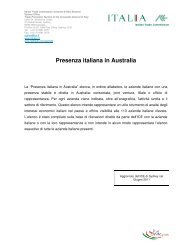Price Determination in the Australian Food Industry A Report
Price Determination in the Australian Food Industry A Report
Price Determination in the Australian Food Industry A Report
Create successful ePaper yourself
Turn your PDF publications into a flip-book with our unique Google optimized e-Paper software.
Supply cha<strong>in</strong> management<br />
Wholesale markets rema<strong>in</strong> a major function with<strong>in</strong> <strong>the</strong> cha<strong>in</strong> where <strong>the</strong> majority of prices through<br />
<strong>the</strong> cha<strong>in</strong> are set or directly <strong>in</strong>fluenced. This is despite an <strong>in</strong>creas<strong>in</strong>g percentage of bus<strong>in</strong>ess direct<br />
to supermarkets to support <strong>the</strong>ir fresh product image and customers, and to obta<strong>in</strong> greater<br />
stability of returns. This practice varies by category based on <strong>the</strong> volume of <strong>in</strong>dividual commodity<br />
l<strong>in</strong>es and <strong>the</strong> scale and sophistication of <strong>the</strong> enterprises.<br />
The size of <strong>the</strong> consumer markets accessed by major supermarket cha<strong>in</strong>s has applied pressure for<br />
coord<strong>in</strong>ation of facets of supply activity (for example, quality management). However, <strong>the</strong> range of<br />
buy<strong>in</strong>g options reduces <strong>the</strong> scope for o<strong>the</strong>r forms of <strong>in</strong>tegration between producers (such as <strong>the</strong><br />
use of open-price supply agreements and mix<strong>in</strong>g supply between direct sources and purchases off<br />
<strong>the</strong> market floor). Seasonal competition exists subject to availability – though this is less of an<br />
issue <strong>the</strong>se days as crops of major l<strong>in</strong>es tend to be available all year.<br />
Ma<strong>in</strong> drivers of prices through <strong>the</strong> cha<strong>in</strong>:<br />
• Retail prices are <strong>in</strong>fluenced by <strong>the</strong> seasonal costs of supply but also by <strong>the</strong> level of spend<strong>in</strong>g by<br />
<strong>the</strong> consumer. The consumer is sensitive to <strong>the</strong> cost of fresh food items that go <strong>in</strong>to <strong>the</strong><br />
shopp<strong>in</strong>g basket.<br />
• The wide range of factors that drive <strong>the</strong> retail pric<strong>in</strong>g of any food category over time are set out<br />
later <strong>in</strong> <strong>the</strong> report.<br />
• As with o<strong>the</strong>r categories, retailers seek a target marg<strong>in</strong> to achieve corporate and/or bus<strong>in</strong>ess<br />
targets but also to cover losses associated with produce spoilage, clearance discount<strong>in</strong>g and <strong>the</strong><br />
labour-<strong>in</strong>tensive bus<strong>in</strong>ess of putt<strong>in</strong>g fresh food appeal <strong>in</strong>to practice with stock display<br />
replenishment and adequate turnover of bay space.<br />
• Wholesale prices (where <strong>the</strong> grower sells produce to a wholesaler who on-sells or sells on <strong>the</strong><br />
grower’s behalf to a retailer) are generally set <strong>in</strong> <strong>the</strong> fresh wholesale market system which exists<br />
<strong>in</strong> capital cities and limited o<strong>the</strong>r major urban centres. The <strong>in</strong>creas<strong>in</strong>g practice of producers<br />
directly supply<strong>in</strong>g retailers to bypass wholesale markets are none<strong>the</strong>less set with reference to<br />
such prices.<br />
<strong>Price</strong> <strong>Determ<strong>in</strong>ation</strong> <strong>in</strong> <strong>the</strong> <strong>Australian</strong> <strong>Food</strong> <strong>Industry</strong> A <strong>Report</strong><br />
• Seasonal crop variations result<strong>in</strong>g from climatic change and o<strong>the</strong>r natural events or causes are<br />
generally <strong>the</strong> greatest s<strong>in</strong>gle production factor to affect prices. Such variations affect:<br />
– higher/lower output than <strong>the</strong> normal crop;<br />
– smaller/larger fruit size;<br />
– climate/storm damage; and<br />
– crop disease and pest damage.<br />
• The wholesale price sett<strong>in</strong>g mechanism is not set to pay <strong>the</strong> highest for best quality but to clear<br />
all product that is supplied. At times it pays low prices for high quality and vice versa.<br />
• A major weakness <strong>in</strong> <strong>the</strong> fresh food market system is <strong>the</strong> lack of discipl<strong>in</strong>e that is sought by <strong>the</strong><br />
supplier to <strong>the</strong> market and <strong>the</strong> general lack of complete <strong>in</strong>formation as to <strong>the</strong> supply and<br />
satisfied demand at any po<strong>in</strong>t <strong>in</strong> time.<br />
• Market pric<strong>in</strong>g is <strong>the</strong>refore open to manipulation by <strong>the</strong> <strong>in</strong>termediary and to a lesser extent by<br />
major buyers due to <strong>the</strong> lack of total market visibility. A major fresh food market is a place for<br />
<strong>the</strong> well <strong>in</strong>formed buyer and seller <strong>in</strong> this day and age. O<strong>the</strong>rwise participants are exposed to<br />
price/return risks, regardless of product quality.<br />
• Supply is still <strong>the</strong> largest driver of price. Markets are relatively un<strong>in</strong>formed with m<strong>in</strong>imal credible<br />
forecast<strong>in</strong>g data or an understand<strong>in</strong>g of <strong>the</strong> volume/price relationship. This leaves much trade<br />
occurr<strong>in</strong>g <strong>in</strong> commodity conditions.<br />
• More organised fresh categories which provide participants with good <strong>in</strong>formation as to total<br />
crop forecasts, market conditions and product availability over a season are far better at<br />
manag<strong>in</strong>g <strong>the</strong> risks that arise from poor <strong>in</strong>formation.<br />
54







